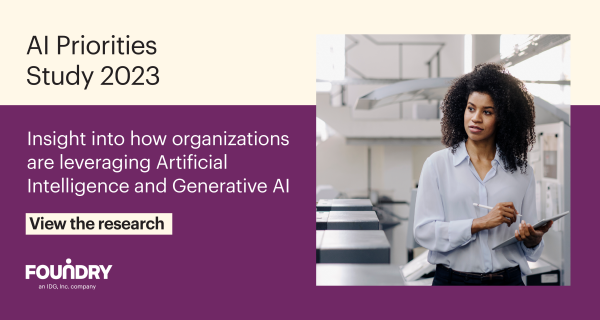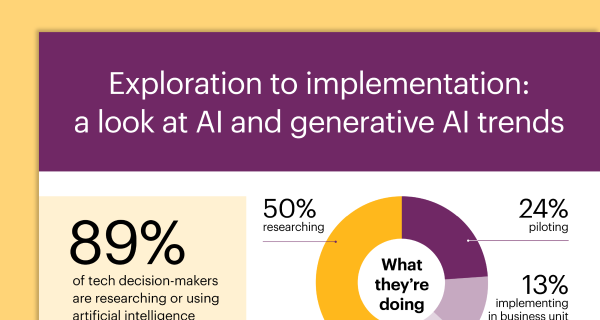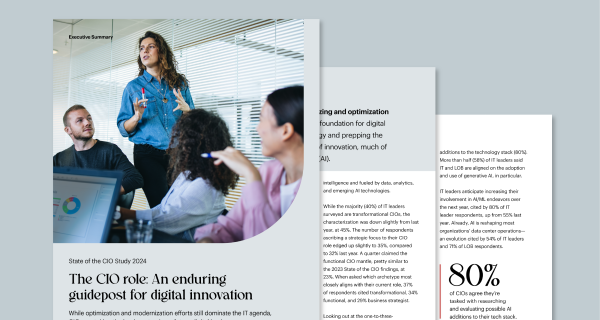AI and machine learning have been providing business value for many years, and now versions such as Generative AI have more easily brought these tools into everyday life, sparking new and vast interest. Foundry’s inaugural AI Priorities study looks at the use cases of AI and Gen AI, investment and implementation levels, measures of success and challenges to better understand how IT decision-makers are using these tools.
Below we’re going to look at one small piece of the research – how employee productivity is a key driver to adoption and how this increased productivity impacts tech buyer engagement.
Investing in AI
Overall, 44% of ITDMs agree that their organization is willing to pay more for AI-infused products from vendors. One of the main reasons they state is due to employee productivity. When asked what business objectives are driving AI investments at their organizations – 48% said improving employee productivity, followed by enabling innovation (43%), and gaining a competitive edge (41%).
With its ability to automate tasks, personalize services, enhance security, and optimize system performance, just to name a few, it is no surprise that a little more than half also say that AI capabilities can and will enable workforce reduction. This increases to 59% for ITDMs at enterprise organizations, likely due to their already larger staff, and is only 50% for SMBs. Thinking about how AI has the power to reduce workforce, we asked respondents to identify their top use cases for AI applications, and leading the top of the list are data analytics, employee productivity, and process automation.
Status of Gen AI
Close to half of respondents to the AI Priorities study say that Gen AI technology is on their radar or being actively researched. The theme of employee productivity continues as 58% agree that they see Gen AI playing a large role in employee productivity and are starting proof of concepts to test. Again, thinking about how IT decision-makers expect Gen AI to support this, respondents stated their primary use cases to be chatbots and virtual assistants, content generation, and industry-specific applications.
We also see technology vendors adding Gen AI capabilities to their already existing software applications and platforms. Thirty-eight percent of ITDMs say that Gen AI capabilities have been added to their productivity/collaboration tools and 86% say that these additions have already resulted in a strong/ somewhat positive impact. More than half (55%) think that these tools would benefit from additional Gen AI capabilities, so it’s clear that they view Gen AI as a productivity tool and expect to see positive benefits from these additions.
These tools don’t only have the ability to reduce workforce, they have the ability to redirect IT to other tasks. Fifty-five percent of ITDMs agree that Gen AI is allowing for employees to refocus on high value-adding tasks. So much of the time, ITDMs are working on functional tasks, such as cost control and improving operating systems. With the use of Gen AI tools, the hope is that they will be able to spend more time developing and refining business strategies, and identifying opportunities for competitive differentiation, to name a few.
Engaging with AI focused tech buyers
Due to the rising complexity of the technology purchase process, ITDMs are constantly searching for ways to free up some of their time and enhance their productivity during the periods that they do have available for fundamental and strategic tasks. We see that AI tools have the ability to do this, so there is no question as to why ITDMs have such strong research and piloting plans, but there are a few things to keep in mind as a tech marketer. When reaching out to tech buyers to promote these new solutions, or current solutions with AI features added, it’s important for technology marketers to be respectful of ITDMs’ time and provide educational resources that are easily digestible. Just because they may be able to redirect their focus to other tasks due to increased productivity, this does not mean that they now all of of this time to sort through irrelevant content. AI-focused tech decision-makers do not want content filled with empty buzzwords. They seek content that addresses their pain points, integration challenges, and offers “how-to” information.
To properly engage tech buyers as they navigate the new AI landscape and work to incorporate Gen AI tools into their day to day, tech vendors must know where their customers and prospects are in the decision-making process and how they are preparing for this integration. ITDMs state that their greatest challenges to AI implementation are IT integration (governance, maintenance, security, etc.), lack of in-house expertise, and business case/justification. Ensure value by creating content that appeals to these areas and providing training where needed.
Further develop your understanding of ITDMs’ AI and Gen AI plans, their current level of satisfaction, and how you can assist them with their implementation by downloading the executive summary or contacting Foundry to explore in more detail.






